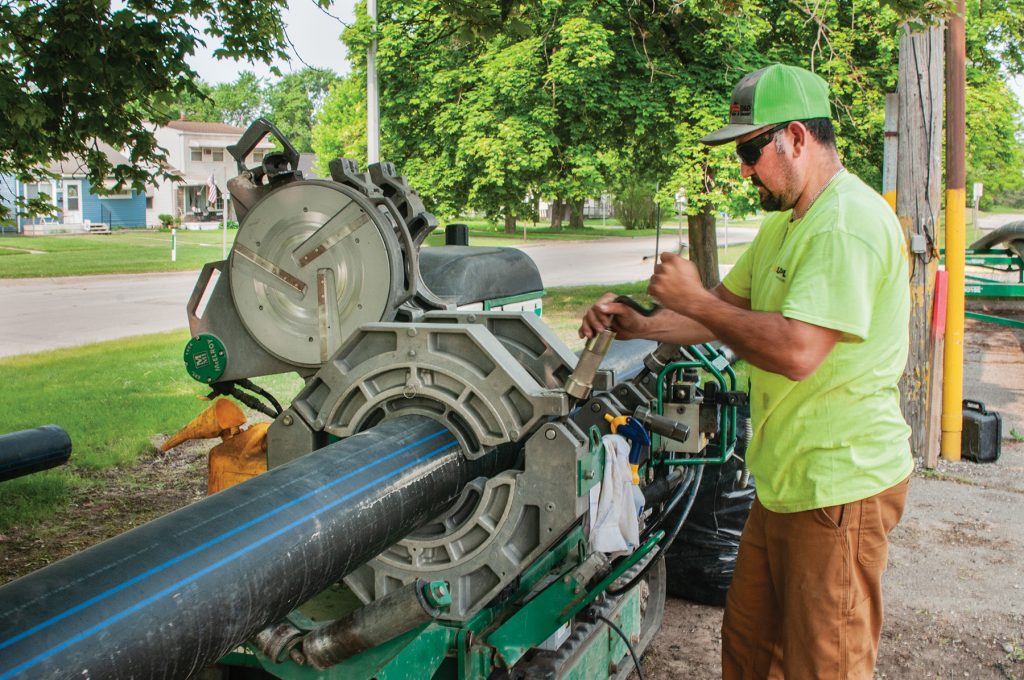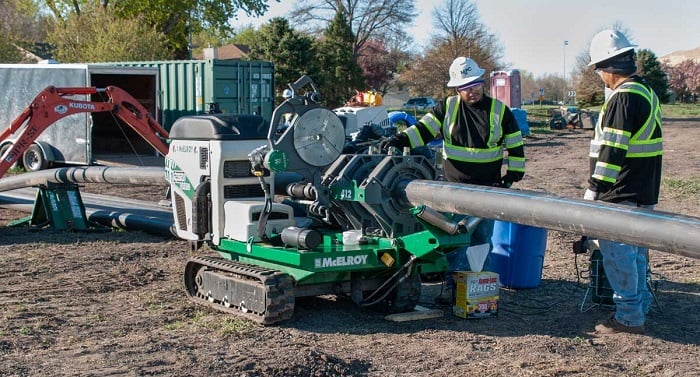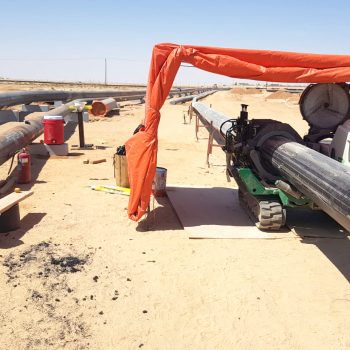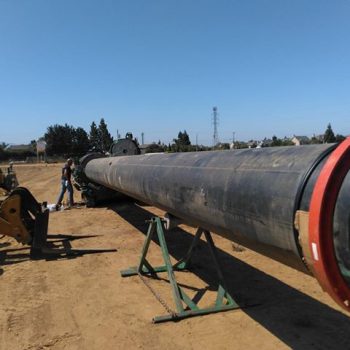Sustainability and efficiency are becoming top priorities for cities looking to replace or revitalize their water infrastructure. As more focus shifts to the topic of water conservation, engineers and city planners are realizing the benefits offered by high-density polyethylene (HDPE) pipes for municipal water systems.
Unlike traditional iron or steel pipes, HDPE is corrosion-resistant, less prone to leaks and can last as long as 100 years when installed properly. Where typical leakage rates of 10% to 20% are deemed “allowable” for PVC and ductile iron pipe, HDPE’s allowable water leakage rate is zero.

Heat-fused HDPE is a proven, leak-free method to connect lengths of HDPE for water piping systems. When fused, HDPE forms a joint that is as strong — or stronger — than the pipe itself, while remaining leak-free. Because it’s produced in 50 ft sticks, the fusions needed to connect a piping system are far fewer than fittings or clamps needed for other piping materials.
In addition, HDPE typically costs less to install than incumbent pipe systems, especially in projects that utilize trenchless installation methods. It’s flexible and durable, reducing or eliminating the need for directional fittings. Its flexibility and durability make it well-suited for systems that bend or are exposed to stressors like earthquakes or temperature fluctuations.
HDPE is designed to last for generations, especially when it’s installed by trained operators following an accepted fusion standard and using quality materials.
While HDPE has been used for decades in municipal water systems, its popularity has surged in recent years.
Omaha’s pipe bursting success
In Omaha, Nebraska, city leaders want to rehabilitate 25 miles (40.2 km) of water mains each year by 2025. The project began in 2019, when the Metropolitan Utilities District (M.U.D.) began ramping up its water infrastructure replacement program. The M.U.D. serves about 600,000 area residents and has a network of water mains about 3,100 miles (4,989 km) long.
The water mains targeted ranged from post-Depression era spun cast iron installed in the 1940s, along with cast iron mains installed in the 1950s and 1960s. Over the years, Omaha crews have also recorded several corrosion hole failures linked to imperfections in poly-wrapped ductile iron pipe installed in the 1990s.
“We knew we needed to shift toward plastic pipe that won’t corrode,” said Infrastructure Integrity Director Jared Svagera. “So, we began a couple of direct replacement projects with HDPE, installed using directional drilling.”

After partnering with Murphy Pipeline Contractors, the M.U.D. began an extensive plan that called for installing HDPE via pipe bursting. This installation method involves an expansion head that’s pulled through an existing line, causing the line to break apart. As the expansion head is pulled through the existing line, it also pulls the new pipeline behind it, immediately filling the space left by the previous pipeline. HDPE is especially well-suited for pipe bursting, due to its durability and flexibility.
Pipe bursting requires less excavation than traditional installation methods, lessening overall costs and minimizing disruptions for residents and businesses around the job site.
The first phase of Murphy’s work in Omaha began in April 2023, with a Murphy crew on-site fusing 6,600 ft (2 km) of 6 inch (152 mm) and 8 inch (203 mm) HDPE in the northwest portion of the city. Fusions were made using a McElroy TracStar® 412 Series 2. Designed to butt fuse pipe sizes from 4 inch IPS to 12 inch DIPS (110 mm to 340 mm), the TracStar 412 series 2 offers a self-contained, self-propelled vehicle that allows fusion technicians to drive the machine directly to the fusion site.
The site superintendent, Jose “Lupe” Quintero, said his crew was able to fuse between 800 ft and 900 ft (.24 km to .27 km) of HDPE each day with a single McElroy fusion machine.
Detroit suburb turns to directional drilling
Other cities are also turning to HDPE for their water infrastructure needs. In Melvindale, a city about 11 miles (17.7 km) from Detroit, Michigan, crews from D&D Water and Sewer, Inc. worked to install about 10,000 ft of HDPE water main in 2023 — this time utilizing an installation method called directional drilling.
During directional drilling, a drill is inserted at the beginning of a piping route. The drill bores a pilot tunnel for the pipe along the route. When the drill reaches the end of the route, the new line is attached and dragged through the newly created tunnel.
Within a roughly two-month window, D&D was able to perform all the pipe fusion, install the water services including installing gate wells, and hook everything together. But there’s still plenty of work to do — city leaders expect the main replacements to last at least through summer 2024. Because many of the existing mains are almost a century old, the city has opted to replace the mains rather than try and line them.
A TracStar® 618 greatly increased jobsite efficiency by allowing a single operator to perform each fusion without the need for additional personnel. D&D fusion technician Augustine Angel handled the fusions from start to finish. A seasoned operator, Angel also took advantage of McElroy’s DataLogger® 7, which captures fusion and joint data for record-keeping and quality assurance. With the DataLogger, Angel was able to accurately record the fusion parameters of each joint and ensure the highest level of integrity throughout the entire process.
It might sound unusual for a single operator to handle every fusion from start to finish, but that kind of efficiency is made much easier with the right equipment for the job. In addition to the TracStar 618 and DataLogger, D&D also utilized a PolyHorse® on site. The PolyHorse is a pipe-handling system designed to hold multiple sticks of pipe, allowing one operator to load and align pipe without the use of extra machinery.
Plow-in makes quick work of South Dakota water line installations
In rural locations, where water lines may span many miles to reach customers, HDPE’s cost effectiveness and ease of installation have made it an attractive option for rural water districts.
Randall Community Water District (RCWD), about two hours southwest of Sioux Falls, South Dakota, serves about 2,800 rural customers and 15 bulk customers from their headquarters in Lake Andes, a community with a population of 710. For decades, RCWD worked with PVC pipe, joining the pipe with bell gaskets. Manager Scott Pick realized he needed to find another solution when it came time to install 13 miles (20.9 km) of 8 inch HDPE. So, the district turned to an installation method known as plow-in.
This method involves threading pre-fused pipe along or into the furrow in a plow. A 6 ft deep pilot hole is dug, then a boot attached to the plow is guided into the pilot hole. The plow is pulled by a high-horsepower bulldozer, and as the plow digs the hole, the pipe threads through the boot and goes into the ground. The soil naturally falls back into the trench, and a bulldozer following behind the plow re-packs the soil, completing the entire process. It’s a method that’s best suited for long, open stretches of land — much like the terrain around Lake Andes.
Plow-in is especially useful in farmland because it can be used to install pipes — such as irrigation lines or water lines — with minimal soil disruption. And it just so happened that farmland made up a large percentage of RCWD’s sites. RCWD’s fusion operators were able to fuse 5 miles at a time without stopping, using McElroy’s TracStar 412. The team was so efficient that the installation, which was expected to take several weeks, was completed in just two days.
In 2022, RCWD installed 22 miles of HDPE. Pick expects that number to more than double this year — and he’s hoping to see the total reach 50 miles.
The McElroy connection
The benefits of HDPE when compared to traditional pipe materials are clear: lower costs, longer lifespan and fewer leaks. But a pipeline is only as good as its installation, and McElroy equipment is designed to boost operator efficiency while also meeting the extreme demands of each specific job site.
In each of the three projects above, operators and project managers praised their McElroy machinery for its rugged reliability, adding that their project timelines were met — or even beaten — thanks in part to the efficiency added by the equipment.
McElroy’s machine lineup spans a wide range of features, both for trenchless and in-ditch applications. TracStar machines are self-contained and self-propelled, allowing them to be driven directly to the job. In the case of these trenchless water projects, the TracStars eliminated the need for additional heavy machinery to move the machines from one place to another.
In addition to its fusion machine lineup, McElroy’s DataLogger 7 allows fusion technicians to log all parameters of each fusion, providing an added layer of accountability. That data is stored in the McElroy Vault, a powerful cloud-based tool that allows for instant, credentialed access to the fusion information from anywhere in the world. That extra layer of oversight — and peace of mind that each joint was fused correctly — is an invaluable addition to infrastructure that serves thousands of people each day.
The world’s water systems are changing. Conservation and efficiency are becoming a top priority worldwide. Along with qualified operators, McElroy continues to lead the way in ensuring that the HDPE water lines installed today will last for generations to come.

